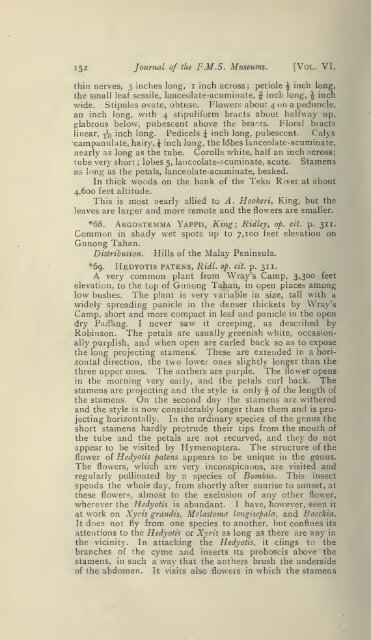Journal of the Federated Malay States museums - Sabrizain.org
Journal of the Federated Malay States museums - Sabrizain.org
Journal of the Federated Malay States museums - Sabrizain.org
You also want an ePaper? Increase the reach of your titles
YUMPU automatically turns print PDFs into web optimized ePapers that Google loves.
152 <strong>Journal</strong> <strong>of</strong> <strong>the</strong> F.M.S. Museums. [Vol. VI,<br />
thin nerves, 3 inches long, i inch across ; petiole ^ inch long,<br />
<strong>the</strong> small leaf sessile, lanceolate-acuminate, f inch long, ^ inch<br />
wide. Stipules ovate, obtuse. Flowers about 4 on a peduncle,<br />
an inch long, with 4 stipuliform bracts about halfway up,<br />
glabrous below, pubescent above <strong>the</strong> bracts. Floral bracts<br />
linear, j^^ inch long. Pedicels ^ inch long, pubescent. Calyx<br />
•campanulate, hairy, ^ inch long, <strong>the</strong> lobes lanceolate-acuminate,<br />
nearly as long as <strong>the</strong> tube. Corolla white, half an inch cicross;<br />
tube very short ; lobes 5, lanceolate-^icuminate, acute. Stamens<br />
as long as <strong>the</strong> petals, lanceolate-acuminate, beaked.<br />
In thick woods on <strong>the</strong> bank <strong>of</strong> <strong>the</strong> Teku River at about<br />
4,600 feet altitude.<br />
This is most nearly allied to A. Hookeri, King, but <strong>the</strong><br />
leaves are larger and more remote and <strong>the</strong> flowers are smaller.<br />
*68. Akgostemma Yappii, King; Ridley, op. cit. p. 311.<br />
Common in shady wet spots up to 7,100 feet elevation on<br />
Gunong Tahan.<br />
Distribution. Hills <strong>of</strong> <strong>the</strong> <strong>Malay</strong> Peninsula.<br />
*69. Hedyotis patens, Ridl. op. cit. p. 311.<br />
A very common plant from Wray's Camp, 3,300 feet<br />
elevation, to <strong>the</strong> top <strong>of</strong> Gunong Tahan, in open places among<br />
low bushes. The plant is very variable in size, tall with a<br />
widely spreading panicle in <strong>the</strong> denser thickets by Wray's<br />
Camp, short and more compact in leaf and panicle in <strong>the</strong> open<br />
dry Padang. I never saw it creeping, as described by<br />
Robinson. The petals are usually greenish white, occasionally<br />
purplish, and when open are curled back so as to expose<br />
<strong>the</strong> long projecting stamens. These are extended in a horizontal<br />
direction, <strong>the</strong> two lower ones slightly longer than <strong>the</strong><br />
three upper ones. The an<strong>the</strong>rs are purple. The flower opens<br />
in <strong>the</strong> morning very early, and <strong>the</strong> petals curl back. The<br />
stamens are projecting and <strong>the</strong> style is only § <strong>of</strong> <strong>the</strong> length <strong>of</strong><br />
<strong>the</strong> stamens. On <strong>the</strong> second da)^ <strong>the</strong> stamens are wi<strong>the</strong>red<br />
and <strong>the</strong> style is now considerably longer than <strong>the</strong>m and is projecting<br />
horizontally. In <strong>the</strong> ordinary species <strong>of</strong> <strong>the</strong> genus <strong>the</strong><br />
short stamens hardly protrude <strong>the</strong>ir tips from <strong>the</strong> mouth <strong>of</strong><br />
<strong>the</strong> tube and <strong>the</strong> petals are not recurved, and <strong>the</strong>y do not<br />
appear to be visited by Hymenoptera. The structure <strong>of</strong> <strong>the</strong><br />
flower <strong>of</strong> Hedyotis patens appears to be unique in <strong>the</strong> genus.<br />
The flowers, which are very inconspicuous, are visited and<br />
regularly pollinated by a species <strong>of</strong> Bombus. This insect<br />
spends <strong>the</strong> whole day, from shortly after sunrise to sunset, at<br />
<strong>the</strong>se flowers, almost to <strong>the</strong> exclusion <strong>of</strong> any o<strong>the</strong>r flower,<br />
wherever <strong>the</strong> Hedyotis is abundant. I have, however, seen it<br />
at work on Xyris grandis, Melastoma longisepala, and Bneckia.<br />
It does not fly from one species to ano<strong>the</strong>r, but confines its<br />
attentions to <strong>the</strong> Hedyotis or Xyris as long as <strong>the</strong>re are any in<br />
<strong>the</strong> vicinity. In attacking <strong>the</strong> Hedyotis, it clings to <strong>the</strong><br />
branches <strong>of</strong> <strong>the</strong> cyme and inserts its proboscis above <strong>the</strong><br />
stamens, in such a way that <strong>the</strong> an<strong>the</strong>rs brush <strong>the</strong> underside<br />
<strong>of</strong> <strong>the</strong> abdomen. It visits also flowers in which <strong>the</strong> stamens

















